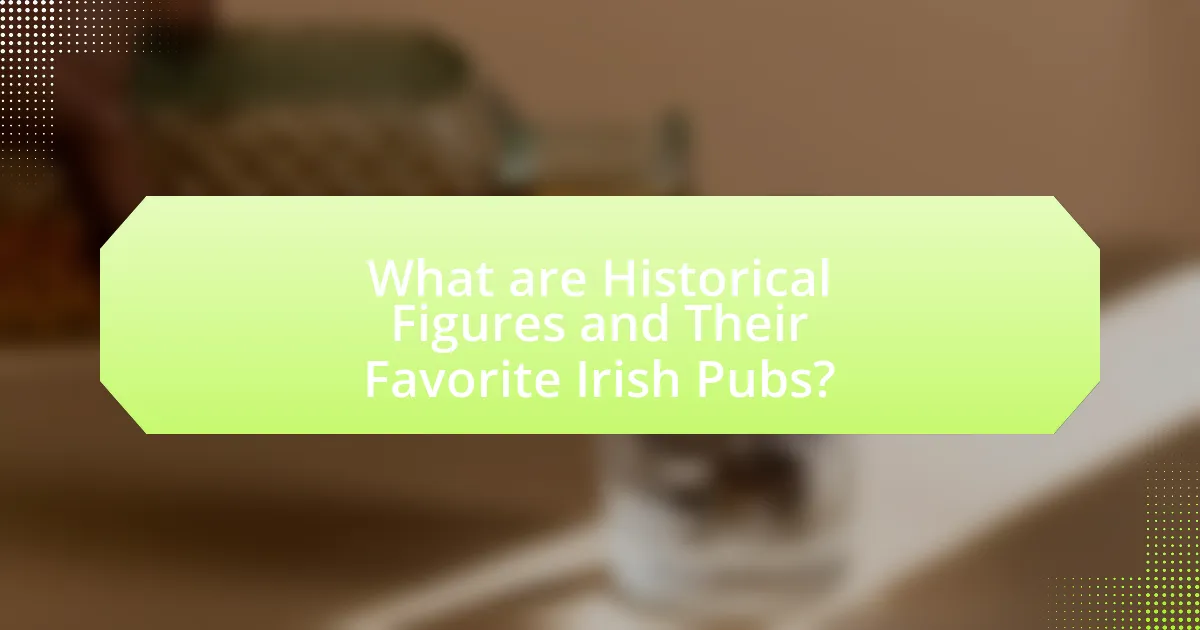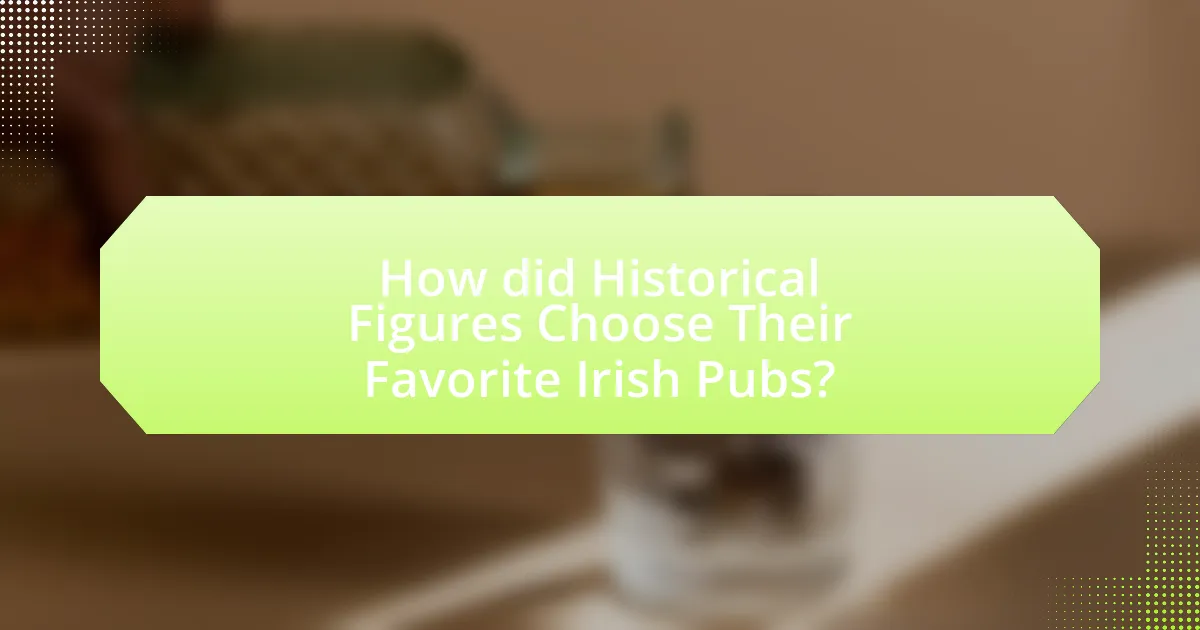The article explores the connections between historical figures and their favorite Irish pubs, highlighting how these establishments served as social and cultural hubs. It examines notable figures such as James Joyce and W.B. Yeats, detailing their preferred pubs and the influence of these venues on their work and social interactions. The significance of Irish pubs in historical contexts, including their role during political movements and cultural preservation, is also discussed. Additionally, the article addresses how personal preferences and social dynamics shaped the choices of these figures, providing insights into the enduring legacy of Irish pub culture.

What are Historical Figures and Their Favorite Irish Pubs?
Historical figures often frequented specific Irish pubs, reflecting their social habits and cultural ties. For instance, James Joyce, the renowned author, was known to enjoy the ambiance of Davy Byrne’s Pub in Dublin, which is featured in his work “Ulysses.” Similarly, the poet W.B. Yeats was associated with the Abbey Tavern in Howth, where he found inspiration. These pubs not only served as social gathering spots but also played a role in the literary and cultural movements of their time, showcasing the intertwined relationship between historical figures and Irish pub culture.
Who are some notable historical figures associated with Irish pubs?
Notable historical figures associated with Irish pubs include James Joyce, who frequently visited the Bailey Pub in Dublin, and Brendan Behan, known for his time spent in the iconic O’Neill’s Pub. Joyce’s works often reflect the pub culture of Dublin, while Behan’s writings were influenced by his experiences in various pubs across Ireland. These associations highlight the significance of Irish pubs in the lives and works of these literary figures.
What roles did these figures play in history?
The historical figures mentioned played significant roles in shaping political, cultural, and social landscapes. For instance, leaders like Winston Churchill influenced global politics during World War II, while literary figures such as James Joyce contributed to modernist literature. Their interactions in Irish pubs often reflected their personal lives and societal issues of their times, providing a backdrop for discussions that influenced their work and decisions. These figures’ legacies are evident in the lasting impact they had on history, culture, and the arts, as seen in their writings, speeches, and policies.
How did their personalities influence their choice of pubs?
Their personalities significantly influenced their choice of pubs by aligning their social preferences and behaviors with the atmosphere and clientele of specific establishments. For instance, extroverted historical figures often gravitated towards lively pubs with vibrant social scenes, where they could engage with a diverse crowd, while more introspective individuals preferred quieter, intimate settings that allowed for deeper conversations. This tendency is evident in the choices of notable figures such as James Joyce, who favored pubs that fostered intellectual discourse, reflecting his literary inclinations, and Oscar Wilde, who was drawn to establishments that matched his flamboyant persona and love for socializing.
Why are Irish pubs significant in the context of history?
Irish pubs are significant in the context of history because they have served as vital social and cultural hubs throughout Ireland’s past. These establishments have been central to community life, providing a space for social interaction, political discourse, and cultural expression, particularly during times of political unrest and social change. For instance, during the Irish War of Independence in the early 20th century, pubs became gathering places for revolutionaries and activists, facilitating discussions that shaped the nation’s future. Additionally, Irish pubs have played a crucial role in preserving and promoting Irish music, language, and folklore, contributing to the cultural identity of Ireland. Their historical significance is further underscored by their resilience, as many have remained operational for centuries, adapting to changing social dynamics while retaining their core functions as community gathering spots.
What cultural aspects do Irish pubs represent?
Irish pubs represent a rich tapestry of community, tradition, and social interaction. These establishments serve as cultural hubs where storytelling, music, and camaraderie flourish, reflecting Ireland’s deep-rooted customs. Historically, pubs have been venues for political discourse and social gatherings, fostering a sense of belonging among patrons. The significance of Irish pubs is underscored by their role in preserving Irish music and folklore, as many feature live performances that celebrate the nation’s artistic heritage. Additionally, the warm and welcoming atmosphere of Irish pubs embodies the concept of “craic,” which emphasizes enjoyment and good conversation, further solidifying their place in Irish culture.
How have Irish pubs served as social hubs throughout history?
Irish pubs have served as social hubs throughout history by providing a communal space for social interaction, cultural exchange, and community bonding. Historically, these establishments have been central to Irish life, acting as venues for storytelling, music, and political discourse. For instance, during the 19th century, pubs became crucial meeting points for local communities, where people gathered to discuss issues such as the Great Famine and Irish independence. Additionally, the tradition of live music and storytelling in pubs has fostered a sense of cultural identity and continuity, making them vital to the preservation of Irish heritage. The role of pubs in facilitating social connections is further evidenced by their inclusion in various literary works, where they are depicted as places of camaraderie and reflection.
What impact did historical figures have on the popularity of certain Irish pubs?
Historical figures significantly boosted the popularity of certain Irish pubs through their patronage and cultural influence. For instance, figures like James Joyce and Samuel Beckett frequented specific establishments, which became associated with their literary legacies. Joyce’s connection to Davy Byrne’s Pub in Dublin, as depicted in “Ulysses,” transformed it into a literary landmark, attracting fans and tourists. Similarly, the historical association of the Brazen Head with notable figures such as Michael Collins and James Connolly has made it a symbol of Irish nationalism, drawing visitors interested in the country’s revolutionary history. These connections create a narrative that enhances the pubs’ appeal, making them destinations for those seeking a deeper cultural experience.
Which pubs became famous due to their association with specific figures?
The pubs that became famous due to their association with specific figures include The Brazen Head, known for its connection to James Joyce, and The Davy Byrnes, which was frequented by the same author. The significance of The Brazen Head lies in its status as Dublin’s oldest pub, established in 1198, and its mention in Joyce’s “Ulysses.” The Davy Byrnes, established in 1889, is noted for its appearance in Joyce’s works and its historical patronage by literary figures.
How did these associations shape the identity of the pubs?
Associations with historical figures significantly shaped the identity of pubs by establishing them as cultural and social hubs. For instance, pubs frequented by renowned writers like James Joyce or Samuel Beckett became synonymous with literary heritage, attracting patrons interested in the arts and fostering a sense of community around shared intellectual pursuits. Additionally, these associations often led to the preservation of pub histories, with memorabilia and themed events that celebrate the legacy of these figures, further embedding their identities into the fabric of the pubs. This connection not only enhances the pubs’ appeal but also reinforces their role as vital spaces for cultural exchange and storytelling in Irish society.

How did Historical Figures Choose Their Favorite Irish Pubs?
Historical figures often chose their favorite Irish pubs based on personal connections, social atmosphere, and the establishment’s reputation for hospitality. For instance, writers like James Joyce frequented pubs such as the Bailey, drawn by the vibrant literary scene and camaraderie among fellow artists. Similarly, political figures like Michael Collins favored pubs that served as meeting points for discussions and strategy, reflecting their need for a welcoming environment conducive to conversation. The selection of these pubs was influenced by their cultural significance, local character, and the quality of service, making them integral to the social lives of these historical figures.
What factors influenced their choices?
Historical figures’ choices of Irish pubs were influenced by personal connections, cultural significance, and social interactions. Personal connections often stemmed from friendships or relationships with pub owners or patrons, creating a sense of belonging. Cultural significance played a role as many pubs served as venues for artistic expression, political discussions, and community gatherings, making them integral to the social fabric of the time. Social interactions, including networking opportunities and the chance to engage with influential figures, further shaped their preferences, as these environments fostered collaboration and inspiration.
How did personal preferences play a role in their selections?
Personal preferences significantly influenced historical figures’ selections of Irish pubs by reflecting their individual tastes, social circles, and cultural values. For instance, figures like James Joyce favored pubs that offered a vibrant atmosphere conducive to conversation and creativity, aligning with his literary pursuits. Similarly, W.B. Yeats often chose establishments that resonated with his nationalist sentiments, indicating a preference for venues that celebrated Irish culture. These selections were not arbitrary; they were deeply rooted in the personal experiences and identities of these individuals, showcasing how their preferences shaped their social interactions and cultural engagements within the context of Irish pub culture.
What social or political contexts affected their pub choices?
Social and political contexts significantly influenced historical figures’ pub choices, as these venues often served as informal meeting places for political discourse and social interaction. For instance, during Ireland’s struggle for independence, pubs became hubs for nationalist discussions, where figures like Michael Collins and James Connolly gathered to strategize against British rule. The political climate of the time, characterized by a push for self-governance, made pubs essential for fostering community solidarity and activism. Additionally, the social dynamics of class and culture shaped preferences, with certain establishments catering to specific social strata, reflecting broader societal divisions. Thus, the interplay of political movements and social hierarchies directly impacted which pubs were frequented by these historical figures.
What were the common characteristics of their favorite pubs?
The common characteristics of historical figures’ favorite pubs included a warm and inviting atmosphere, a rich selection of local beers and spirits, and a strong sense of community. These pubs often featured traditional Irish music, which enhanced the social experience, and were typically located in vibrant neighborhoods that encouraged interaction among patrons. Additionally, many of these establishments had historical significance or were frequented by notable personalities, adding to their charm and appeal.
How did the ambiance of these pubs appeal to historical figures?
The ambiance of these pubs appealed to historical figures through their warm, inviting atmosphere and rich cultural heritage. The combination of cozy interiors, lively conversations, and traditional music created a sense of community and comfort that attracted notable individuals. For instance, figures like James Joyce and Samuel Beckett frequented these establishments, drawn by the vibrant social scene and the opportunity for intellectual exchange. The historical significance of these pubs, often steeped in local lore and artistic inspiration, further enhanced their allure, making them ideal gathering places for influential thinkers and creatives.
What types of patrons frequented these pubs alongside historical figures?
Various types of patrons frequented these pubs alongside historical figures, including local artists, writers, politicians, and everyday working-class individuals. For instance, pubs like the Davy Byrnes in Dublin attracted literary figures such as James Joyce, while also serving as a social hub for the general public. This blend of patrons created a vibrant atmosphere where influential conversations and cultural exchanges occurred, reflecting the social dynamics of the time.

What Can We Learn from Historical Figures and Their Favorite Irish Pubs?
Historical figures often frequented Irish pubs, revealing insights into their personalities, social interactions, and cultural influences. For instance, figures like James Joyce and W.B. Yeats found inspiration and camaraderie in these establishments, highlighting the role of pubs as cultural hubs in Ireland. The frequenting of pubs by such influential individuals underscores the significance of these spaces in fostering creativity, dialogue, and community engagement. Additionally, the choice of specific pubs often reflects the historical and social context of the time, providing a lens through which we can understand the values and social dynamics of different eras.
How can modern patrons appreciate the legacy of these pubs?
Modern patrons can appreciate the legacy of these pubs by engaging with their historical significance and cultural heritage. Many of these establishments have been frequented by notable historical figures, such as writers, politicians, and artists, which adds depth to their legacy. For instance, pubs like Davy Byrne’s in Dublin were frequented by James Joyce, making them integral to literary history. Patrons can also participate in guided tours that highlight the stories and events associated with these venues, fostering a deeper understanding of their role in social and cultural contexts. Additionally, enjoying traditional Irish music and cuisine within these pubs allows patrons to connect with the local culture, further enriching their appreciation of the pubs’ historical importance.
What traditions can be upheld in these historical pubs today?
Historical pubs can uphold traditions such as live music sessions, storytelling nights, and the serving of traditional Irish dishes and beverages. These practices not only celebrate the cultural heritage associated with these establishments but also foster community engagement. For instance, many historical pubs host regular music events that feature traditional Irish folk music, which has been a staple in Irish culture for centuries. Additionally, storytelling nights allow patrons to share tales, preserving the oral traditions that have been passed down through generations. The continued offering of classic dishes like Irish stew and beverages such as Guinness reinforces the culinary traditions that are integral to the pub experience in Ireland.
How can visitors engage with the history of these pubs?
Visitors can engage with the history of these pubs by participating in guided tours that highlight their historical significance and connections to notable figures. These tours often include storytelling about famous patrons, architectural details, and the evolution of the pub culture in Ireland. For instance, many pubs have preserved artifacts and memorabilia that reflect their storied past, allowing visitors to experience the ambiance that historical figures once enjoyed. Additionally, some pubs offer interactive experiences, such as themed events or tastings, that further immerse visitors in the rich history associated with these establishments.
What are some tips for exploring historical pubs in Ireland?
To explore historical pubs in Ireland effectively, start by researching the history and significance of each pub you plan to visit. Many pubs, such as The Brazen Head in Dublin, claim to be the oldest in Ireland, dating back to 1198, and often feature historical artifacts and stories that enhance the experience. Engage with local guides or historians who can provide insights into the cultural and historical context of the pubs, as well as anecdotes about famous patrons like James Joyce or Samuel Beckett. Additionally, consider visiting during traditional music sessions or storytelling nights, which are common in many historical pubs, as these events often reflect the local heritage and community spirit.
How can one find pubs with rich historical significance?
To find pubs with rich historical significance, one can research local history resources, such as historical societies or archives, which often document notable establishments. Additionally, visiting websites dedicated to historical landmarks or cultural heritage can provide insights into pubs that have played a role in significant events or have connections to famous historical figures. For example, the “Historic Pubs of Dublin” guide details establishments frequented by literary figures like James Joyce and Samuel Beckett, highlighting their historical context. Engaging with local historians or participating in guided tours can also uncover lesser-known pubs with intriguing backstories.
What should visitors look for to enhance their experience in these pubs?
Visitors should look for the historical significance of the pubs to enhance their experience. Many Irish pubs have rich histories tied to famous literary figures, politicians, and artists, which can provide context and depth to the visit. For example, pubs like Davy Byrne’s in Dublin are known for their connections to James Joyce, who featured the establishment in his works. Engaging with the pub’s history, such as its role in local culture or its architectural features, can greatly enrich the overall experience.
